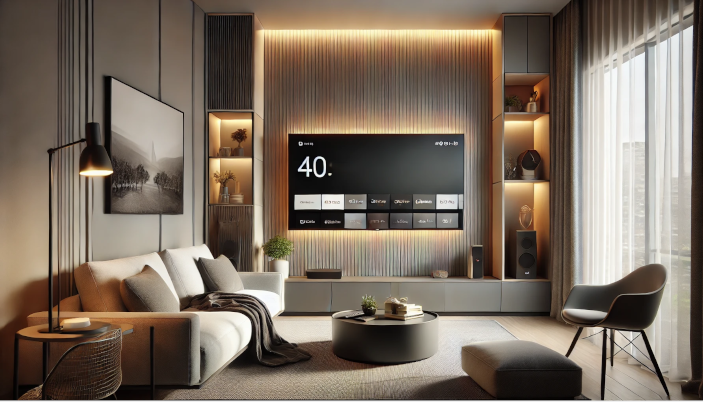Identifying the ideal Smart TV for a limited space—whether it be a studio apartment, a modest bedroom, or a compact home office—requires a nuanced approach. A balance must be struck between technological sophistication, functional versatility, and spatial harmony. Given the extensive array of options available in today’s market, it is critical to align the device’s attributes with the physical constraints and specific viewing needs of your environment. Below, we provide an advanced framework of considerations to guide your selection process.
1. Evaluate Spatial Dimensions and Viewing Dynamics
An essential preliminary step is to quantify the spatial dimensions of the intended installation site, factoring in both physical parameters and optimal viewing distance. For confined environments, screens within the 32 to 43-inch range are generally the most pragmatic. To ensure ergonomic viewing, adhere to these recommendations:
- A screen size of 32 inches is appropriate for a viewing distance of 4-6 feet.
- A 40-43 inch display is suitable for distances extending to 6-8 feet.
Exceeding these dimensions risks spatial dissonance, potentially overshadowing the room’s aesthetics and functionality.
2. Emphasize Sleek Profiles and Reduced Bezels
Modern Smart TVs equipped with slim profiles and narrow bezels provide dual benefits: a streamlined physical footprint and an aesthetically sophisticated presence. These attributes maximize the screen-to-body ratio, enhancing visual immersion without exacerbating spatial constraints. Advanced models even incorporate adaptive features, such as customizable bezels and ambient displays that seamlessly integrate with existing decor.
3. Optimize Wall-Mounting Configurations
Wall-mounting serves as a space-saving strategy par excellence. Prioritize Smart TVs that conform to VESA standards for mounting compatibility. Evaluate the functional range of mounts, with fixed brackets delivering a minimalist appearance and tilt/swivel mounts offering enhanced positional versatility. Professional installation is advisable to ensure structural integrity and aesthetic alignment, particularly in intricate layouts.
4. Elevate Visual Performance Parameters
In compact spaces, superior visual fidelity remains indispensable for an engaging media experience. Key specifications to prioritize include:
- 4K Resolution: Offers an unparalleled pixel density, rendering crisp visuals even on smaller screens, essential for textural detail and image clarity.
- HDR Capability: Facilitates an expanded color gamut and improved contrast ratios, crucial for dynamic and lifelike imaging in both shadowed and brightly lit scenes.
Although Full HD (1080p) options can suffice for budget-conscious consumers, the diminishing cost differential often justifies an upgrade to 4K for future-proofing and enhanced viewing quality.
5. Advanced Smart Functionality and Platform Integration
Ensure the Smart TV supports a robust ecosystem of applications and streaming services integral to your media consumption. Platforms such as Netflix, Hulu, Disney+, and emerging players like Apple TV+ should be readily accessible. Additionally, models equipped with AI-driven voice assistants (e.g., Alexa, Google Assistant) enhance operational convenience through voice-based navigation and smart home integration.
Further, investigate secondary functionalities such as screen mirroring, smartphone casting, and web browsing capabilities. An intuitive user interface is paramount to streamline interaction and minimize navigational complexity.
6. Acoustic Quality in Compact Settings
The acoustic performance of smaller TVs often necessitates supplementary measures to mitigate audio limitations. Seek models featuring advanced sound processing technologies such as Dolby Audio or DTS Virtual:X. For amplified soundscapes, a compact soundbar or bookshelf speakers provide scalable solutions. Some high-end soundbars are designed to incorporate subwoofers or spatial sound simulations, which significantly enrich auditory immersion even in constrained environments.
7. Prioritize Energy Efficiency Metrics
In smaller spaces, the thermal and energy output of electronic devices can exert disproportionate effects. Opt for Energy Star-certified models or devices featuring eco-modes that dynamically regulate brightness and power consumption based on ambient conditions. Such measures not only reduce environmental impact but also contribute to sustained cost efficiencies.
8. Comprehensive Connectivity Capabilities
Examine the device’s connectivity portfolio to ensure compatibility with ancillary technologies. Essential components include:
- HDMI Ports: For external media players, gaming consoles, and other peripherals.
- USB Inputs: To facilitate direct playback of locally stored media.
- Bluetooth/Wi-Fi: For seamless integration with wireless audio systems and networked devices.
A higher count of HDMI ports is advantageous for multi-device setups, while Ethernet compatibility provides added reliability for streaming-intensive applications.
9. Financial Planning and Value Optimization
Establishing a clear budgetary framework streamlines the selection process. Renowned brands such as Samsung, LG, Sony, and TCL offer tiered solutions ranging from cost-effective to premium. Consider ancillary expenditures, including wall mounts, audio accessories, and subscription services. Strategic timing, such as purchasing during sales events, can yield significant financial advantages.
10. Leverage Peer Insights and Manufacturer Warranties
Scrutinize user reviews and professional evaluations to ascertain the functional reliability and experiential value of shortlisted models. Emphasis should be placed on customer service quality and warranty provisions, with extended warranties often proving beneficial in safeguarding against unforeseen technical issues.
Conclusion
Selecting an optimal Smart TV for a small space necessitates a sophisticated synthesis of size, functionality, and aesthetic considerations. By aligning your choice with spatial constraints, technological preferences, and fiscal priorities, you can achieve a harmonious integration that elevates your entertainment experience. Deliberation and informed comparisons are instrumental; with meticulous planning, even compact environments can be transformed into immersive viewing sanctuaries. Engage thoughtfully in this process, and your investment will yield enduring satisfaction.

